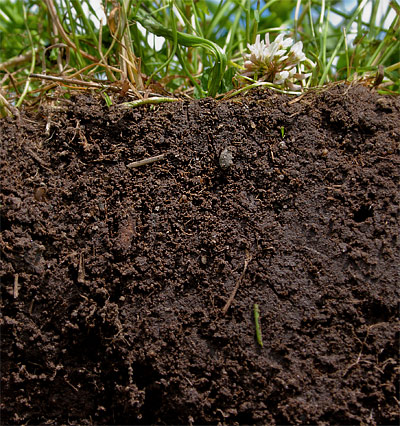In Nature every living things dies, decomposes, and contributes its building materials back to its environment. In Nature there is no waste. But, without microbial activity the bodies of plants and animals would never break down. A plethora of bacteria and fungi work on the microscopic scale to break down once living tissue. Availability of water and air also has a profound effect on which groups of microbes flourish in decaying matter. Too much water and too little air will lead to favorable conditions for anaerobes (and stinky byproducts), while too little water and too much air may lead to a very slow decay process by anything, aerobic or anaerobic.
Environmental temperatures also affect the rate of decay. That's why soils in warm and tropical climates run low on organic matter -- the rate of microbial activity consuming once living material works much faster than cooler environments. And very cold climates, like the tundra, accumulate partially and completely undecomposed plant material in thick layers. Decomposition occurs at an incredibly slow rate when it's cold for most of the year, but changes in the rate of decay in the tundra environment have been noted over the past two decades (Sistla, 2013). And even though there are mixed models predicting global soil carbon with climate change (Wieder, 2013), it's generally recognized that higher temperatures mean more microbial activity and faster carbon consumption in soils.
The forests and grasslands offer a look at the natural top down decay and integration process. While deep roots of some grasses and trees contribute their dead roots many feet below the surface into the subsoil. Consequently upper layers of soil in wilderness settings will have far more organic matter than lower, with further descent revealing the base material of the soil (the inorganic rock material).
A managed composting system aims to imitate and speed up this natural decay process, producing rich organic matter for food-producing gardens and crops. Finished compost is Nature’s system of returning nutrients, in useable form, to growing plants. But carbon, nitrogen, potassium, and other trace nutrients, are only part of the picture. Decayed plant material also improves the structure of the soil. "This means the soil will be easier to work, will have good aeration and water-retention characteristics, and will be resistant to erosion," Mr. Jeavons writes. "The best way to control insects and diseases in plants is with a living, healthy soil rather than with poisons that kill beneficial soil life."
Sources
Jeavons, John. How to Grow More Vegetables (and fruits, nuts, berries, grains, and other crops) than you ever thought possible on less land than you can imagine. 8th ed. (2012).
Sistla, Seeta A.; More, John C.; Simpson, Rodney T.; Gough, Laura; Shaver, Gaius R.; Schimel, Joshua P. "Long-term warming restructures Arctic tundra without changing net soil carbon storage." Nature 497, 615-618 (15 May, 2013).
Wieder, William R., Bonan, Gordon B., Allison, Steven D., "Global soil carbon projections are improved by modelling microbial processes." Nature Climate Change 3, 909-912 (28 July, 2013).
